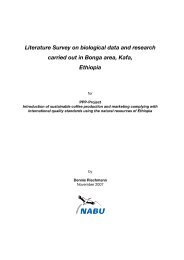Flora Biodiversity Assessment in Bonga, Boginda and Mankira Forest
Flora Biodiversity Assessment in Bonga, Boginda and Mankira Forest
Flora Biodiversity Assessment in Bonga, Boginda and Mankira Forest
You also want an ePaper? Increase the reach of your titles
YUMPU automatically turns print PDFs into web optimized ePapers that Google loves.
5. PROPOSAL FOR CORE, BUFFER AND TRANSITIONAL AREAS<br />
Underst<strong>and</strong><strong>in</strong>g concepts of core, buffer <strong>and</strong> transition as described by UNESCO 2006 11<br />
vis-a-vis the exist<strong>in</strong>g management system <strong>in</strong> those three study areas was necessary before<br />
mapp<strong>in</strong>g the area <strong>in</strong>to these three functional zones. The procedure used to map this out is<br />
the follow<strong>in</strong>g:<br />
• The flora <strong>in</strong> general is under high pressure ma<strong>in</strong>ly as a result of anthropogeneic<br />
reasons. The current survey <strong>and</strong> other studies conducted before revealed that<br />
biodiversity <strong>in</strong> the forest are higher than those on other l<strong>and</strong>cover. Therefore<br />
ma<strong>in</strong>ta<strong>in</strong><strong>in</strong>g the exist<strong>in</strong>g forest cover is taken as the first criteria for categoriz<strong>in</strong>g<br />
the l<strong>and</strong> <strong>in</strong> one of the three mentioned functions.<br />
• Steep sloped areas are more prone to l<strong>and</strong>slide <strong>and</strong> soil erosion than gentle slopes.<br />
In the study area many places that are threatened by erosion <strong>and</strong> l<strong>and</strong>slide are<br />
observed. Especially <strong>in</strong> the absence of good vegetation cover this problem affects<br />
wide areas as the natural topography of <strong>Bonga</strong> is highly slopp<strong>in</strong>g rang<strong>in</strong>g from 10<br />
% to over 60 % (TAM Agribus<strong>in</strong>ess 2004 cited <strong>in</strong> Riechmann D., 2007). Thereore<br />
from SRTM database slope percent was calculated <strong>and</strong> classified <strong>in</strong>to two classes<br />
namely slope class I <strong>and</strong> slope class II. Slope class I comprises slopes less than or<br />
equal to 30 percent <strong>and</strong> slope class II comprises areas that are greater than 30<br />
percent.<br />
• Altitude was taken as one criterion for this zonation. But this altitude variation<br />
does not apply for “Dense <strong>Forest</strong>” stratum. Similar to slope classifiction altitude<br />
above sea level of the study area is divided <strong>in</strong>to two: areas greater than 1900 masl<br />
<strong>and</strong>, areas less than 1900 masl. This division is considered because of the<br />
distribution of Coffea arabica. Accord<strong>in</strong>g to Kaffa zone Agriculture <strong>and</strong> Rural<br />
Development Bureau, the altitud<strong>in</strong>al range of coffee does not exceed upper limit<br />
of 1900 though Schmitt C. B., 2006 reported that wild coffee grows throughout<br />
the forest until 2,050 masl except for extremely shaded <strong>and</strong> humid sites.<br />
11 See annex I for def<strong>in</strong>ition<br />
58



